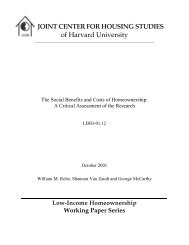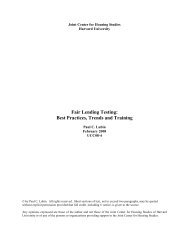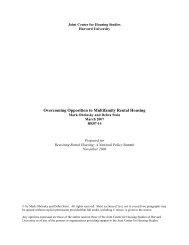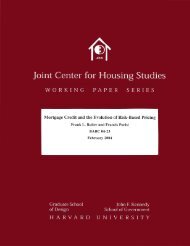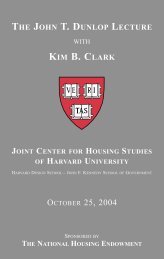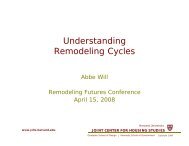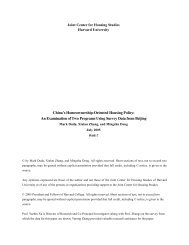please do not cite or circulate without permission of the authors
please do not cite or circulate without permission of the authors
please do not cite or circulate without permission of the authors
You also want an ePaper? Increase the reach of your titles
YUMPU automatically turns print PDFs into web optimized ePapers that Google loves.
two New Y<strong>or</strong>k housing programs also bolstered <strong>the</strong> number <strong>of</strong> homeowners in <strong>the</strong>ir<br />
communities, which may, in itself, lead to higher property values if <strong>the</strong>ir greater financial<br />
stake leads homeowners to take better care <strong>of</strong> <strong>the</strong>ir homes than renters. Similarly, <strong>the</strong>re is<br />
some evidence that homeowners are m<strong>or</strong>e involved in local <strong>or</strong>ganizations and activities<br />
(both because <strong>of</strong> <strong>the</strong>ir financial stake and because homeowners simply tend to remain in<br />
<strong>the</strong>ir homes f<strong>or</strong> a longer period <strong>of</strong> time); this fact<strong>or</strong> may improve <strong>the</strong> quality <strong>of</strong> life in a<br />
community and <strong>the</strong>reby raise property values (DiPasquale and Glaeser 1999; Rohe, Van<br />
Zandt, and McCarthy 2000).<br />
Finally, <strong>the</strong>se two programs also lead to an increase in <strong>the</strong> population <strong>of</strong> <strong>the</strong>ir<br />
neighb<strong>or</strong>hoods, which may, in turn, have invited new commercial activity, a greater sense<br />
<strong>of</strong> safety, and general economic growth.<br />
There are, to date, few reliable studies examining <strong>the</strong> impact <strong>of</strong> privately<br />
spons<strong>or</strong>ed new construction on surrounding property values, largely due to <strong>the</strong> difficulty<br />
<strong>of</strong> addressing en<strong>do</strong>geneity problems. (Private developers aim to develop sites where <strong>the</strong>y<br />
believe property values are likely to appreciate, and thus new construction itself depends<br />
on property values.) Simons, Quercia, and Maric (1998) use cross-sectional data f<strong>or</strong><br />
Cleveland to examine <strong>the</strong> effect <strong>of</strong> one- to three-family home construction on <strong>the</strong> sales<br />
prices <strong>of</strong> nearby housing. They find that <strong>the</strong> existence <strong>of</strong> a newly constructed unit nearby<br />
has a small, but positive effect on sales price. Although <strong>the</strong> auth<strong>or</strong>s attempt to treat<br />
construction as en<strong>do</strong>genous using two-stage least squares, <strong>the</strong> po<strong>or</strong> perf<strong>or</strong>mance <strong>of</strong> <strong>the</strong><br />
first-stage model (explaining new construction in a census tract) leads <strong>the</strong>m ultimately to<br />
use actual levels <strong>of</strong> new construction in <strong>the</strong>ir regression models.<br />
Most studies <strong>of</strong> <strong>the</strong> relationship between investments in housing and<br />
neighb<strong>or</strong>hood property values focus instead on <strong>the</strong> impact <strong>of</strong> proximity to publiclysubsidized<br />
housing, and in particular, proximity to federally-subsidized rental programs.<br />
So far, few studies suggest much <strong>of</strong> an effect. Nourse (1963) and Rabiega, Lin, and<br />
Robinson (1984), f<strong>or</strong> example, examine <strong>the</strong> effect <strong>of</strong> newly developed public housing on<br />
neighb<strong>or</strong>ing property values and both find modest, positive impacts, but only in limited<br />
cases. M<strong>or</strong>e recently, Chandler, Benson and Klein (1993) find that <strong>the</strong> siting <strong>of</strong> scatteredsite<br />
public housing in Cleveland was associated with increases in sales prices in 8 <strong>of</strong> 12<br />
census tracts, but <strong>the</strong>se auth<strong>or</strong>s <strong>do</strong> <strong>not</strong> control f<strong>or</strong> <strong>the</strong> effects <strong>of</strong> neighb<strong>or</strong>hood conditions.<br />
In a m<strong>or</strong>e th<strong>or</strong>ough analysis, Briggs, Darden, and Aidala (1999) undertake a pre/post<br />
2



